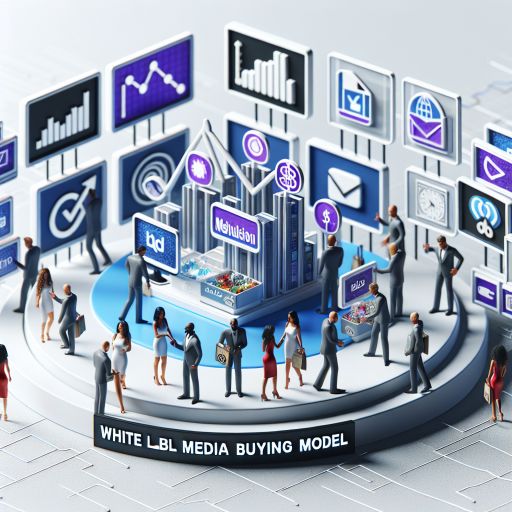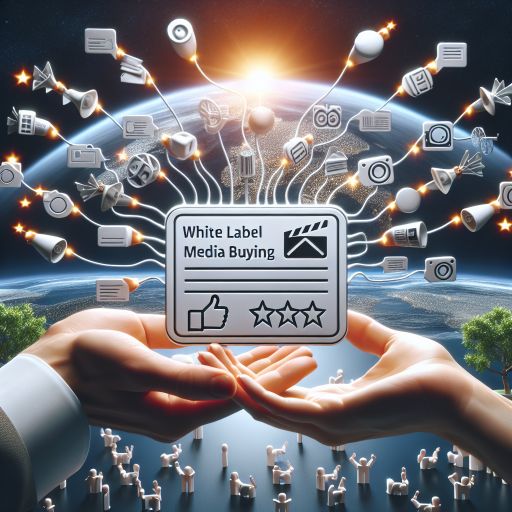In today’s digital landscape, businesses are adopting white label media buying to maximize reach and revenue. This strategy enables companies to rebrand media buying services, integrating expertise and resources seamlessly. Particularly beneficial for niche markets, it allows tailored marketing strategies without heavy investment in a new infrastructure. Key features include customized solutions, expertise access, rapid scalability, and brand enhancement, leading to increased operational efficiency and expanded market reach.
Introduction to White Label Media Buying and Its Relevance in Niche Markets
In today’s rapidly evolving digital landscape, businesses are continuously seeking innovative methods to expand their reach and maximise revenue. One such strategy that is gaining prominence is white label media buying. This approach allows companies to rebrand a media buying service, created by another company, with their own brand. The result is a seamless integration of expertise and resources, enabling businesses to focus on their core competencies while expanding their service offerings.
White label media buying is particularly relevant for niche markets, which are often underserved by traditional advertising channels. Due to their specific and focused audience, these markets require tailored marketing strategies. Through white label solutions, businesses can provide customised advertising services that cater specifically to the unique demands of these niche audiences, without the need to invest heavily in building their own media buying infrastructure from scratch.
A critical aspect of white label media buying is its ability to enhance existing capabilities while saving companies significant time and money. Businesses, particularly those in niche markets, can capitalise on the pre-existing expertise of media buying specialists, ensuring that their campaigns are both efficient and effective.
White Label Media Buying: Key Features
To understand white label media buying, it is helpful to consider its key features and how they contribute to revenue growth:
- Customised Solutions: Offers bespoke media buying services tailored to specific industries.
- Expertise Access: Provides access to a wealth of knowledge and skilled professionals.
- Scalability: Enables businesses to scale their operations rapidly without significant upfront investment.
- Brand Enhancement: Allows companies to strengthen their brand by offering expanded services.
According to recent market analysis, companies leveraging white label solutions see a noticeable increase in their operational efficiency and market reach. A report from eMarketer highlights this trend, demonstrating how white label services empower businesses to deliver improved results swiftly.
| Aspect | Impact on Niche Markets |
|---|---|
| Operational Efficiency | Increased by leveraging expert resources. |
| Market Reach | Expanded through targeted advertising solutions. |
In conclusion, white label media buying offers a strategic advantage for businesses operating in niche markets, providing them with the tools to efficiently meet the specific demands of their audiences while unlocking new revenue streams.
Understanding the Concept of White Label Solutions
White label solutions have become an integral part of various business sectors, providing companies the ability to offer products or services under their own brand name without having to develop these from scratch. A white label product or service is produced by one company and then rebranded by another to make it appear as if the latter developed it.
In the marketing and advertising realm, white label services allow companies to optimize their offerings by leveraging the expertise and resources of specialized providers while maintaining their own brand identity. This approach not only accelerates the time to market but also ensures that businesses can offer a high-quality service without the heavy investment typically required for product development.
One of the main attractions of white label solutions is cost efficiency. Companies can save on research and development expenses and instead allocate those resources towards marketing, sales, and customer support. The ability to scale quickly without the traditional barriers associated with product launches can be a significant competitive advantage, especially for businesses operating in rapidly changing niche markets.
The versatility of white label solutions is exhibited across multiple domains, from software services and financial solutions to consumer goods and technology products. By partnering with established providers, businesses can quickly add to their product portfolio without the burdens of production and logistics.
The table below highlights key sectors where white label solutions are prominently utilized:
| Sector | White Label Application |
|---|---|
| Financial Services | Banking software, investment platforms |
| Technology | SaaS platforms, mobile applications |
| Consumer Goods | Private label food and beverage products |
| Marketing | SEO services, social media management tools |
| Healthcare | Telemedicine solutions, healthcare monitoring apps |
The concept of white label solutions is evolving alongside advancements in technology and digital services. It represents an adaptable, resource-efficient model that aligns well with the needs of businesses in niche markets. Understanding and leveraging these solutions can empower businesses to unlock new revenue streams and expand their market presence effectively.
The Rise of Niche Markets in the Digital Age
The digital landscape is continuously evolving, leading to the emergence and growth of niche markets. As these specialized segments expand, businesses and marketers have the opportunity to engage with more precise audiences through targeted strategies, like white label media buying.
Niche markets are defined by their specific focus on unique sets of products or services that cater to specialized interests or needs within the broader marketplace. The proliferation of digital platforms and online communities has significantly contributed to the rise of these markets, creating microcosms of consumer interest that were challenging to reach with traditional methods.
One contributing factor to the rise of niche markets is the advancement of technology, which has facilitated better data analytics and consumer insights. These innovations allow businesses to identify and understand smaller segments in greater detail, enabling more personalized marketing approaches.
Alongside technology, cultural trends and changing consumer preferences have further fueled the growth of niche markets. As people seek more personalized and relevant content, products, and services, businesses are responding by tailoring their offerings to align more closely with these preferences.
The increase in niche markets also presents opportunities in terms of competition. While mainstream markets may be saturated with numerous players, niche markets often offer spaces for businesses to distinguish themselves by addressing specific consumer needs more effectively.
Global Reach and Growth
The growth of niche markets is not limited to any single region; it is a worldwide phenomenon. Businesses that recognize and seize opportunities within these specialized segments can expand their reach and influence beyond local or national boundaries.
| Region | Percentage Growth in Niche Markets (last 5 years) |
|---|---|
| North America | 15% |
| Europe | 17% |
| Asia-Pacific | 22% |
| Latin America | 12% |
The data in the table above showcases the regional growth of niche markets, highlighting Asia-Pacific as a leading region where niche segments are expanding rapidly. This trend underscores the global potential of niche markets, which can be unlocked through strategic initiatives like white label media buying.
By embracing the unique characteristics of niche markets and their increasing presence in the digital spectrum, businesses can strategically align themselves with the interests and needs of these audiences, paving the way for new revenue streams and sustainable growth.
Advantages of White Label Media Buying for Niche Businesses
White label media buying offers a compelling array of advantages for niche businesses looking to expand their revenue streams. By leveraging the resources and expertise of an established media buying agency, niche businesses can focus their efforts on core competencies while enjoying the benefits of increased marketing efficiency.
One of the primary advantages is cost-effectiveness. White label solutions allow niche businesses to access high-quality media buying services without the need to build their own team from scratch. This not only reduces overhead costs but also provides the business with the opportunity to scale its marketing efforts without significant upfront investments.
Another significant advantage is access to advanced tools and technology. White label media buying services typically utilize cutting-edge technology platforms and analytics tools to optimize ad placements and budgets effectively. This ensures that niche businesses can achieve maximum reach and engagement with their target audience, enhancing their advertising strategy with industry-leading solutions.
Additionally, expertise and experience are critical factors in the success of any media buying campaign. White label providers bring a wealth of industry knowledge and experience to the table, allowing niche businesses to benefit from proven strategies and insights derived from a broad range of client experiences.
Speed to market is also a considerable advantage. With a ready-made infrastructure and streamlined processes, white label media buying services can launch campaigns quickly, allowing niche businesses to respond promptly to market trends and consumer demands. Faster implementation means businesses can start seeing returns on their investment sooner than if they were to develop in-house capabilities.
Furthermore, this approach provides flexibility and scalability. Niche businesses can tailor their media buying services to fit their specific needs, whether that involves scaling up during peak seasons or scaling down during quieter periods. This flexibility ensures that businesses can adapt rapidly without long-term commitments or high fixed costs.
Finally, white label media buying enhances focus and strategic alignment. By outsourcing media buying tasks, niche businesses can devote more resources to refining their products and services, enhancing customer relationships, and pursuing strategic growth opportunities that align with their overarching business goals.
Exploring Successful White Label Media Buying Models

White label media buying models have gained significant traction in recent years, offering businesses an efficient way to expand their services without the need for extensive resource allocation. To understand how various frameworks contribute to this trend, it is important to explore the structures that facilitate their success.
Several organizations have leveraged white label media buying models effectively by establishing a strong partnership framework. These frameworks typically include strategic alliances between agencies that possess the technological infrastructure and niche brands that aim to integrate such offerings into their portfolio.
Standardized Process Models are common among successful white label media operations. By adhering to pre-defined guidelines for media buying, companies can ensure consistency, quality, and efficiency in their service delivery. This approach is particularly valuable for niche markets where brand-specific messaging needs to be communicated effectively and precisely.
Customized Integration Models enable brands to mold the white label solutions to better align with their unique market requirements. Providers offer adaptable platforms that allow clients to tailor services, thereby enhancing the relevance of the media content for the target audience.
Another prevalent model is the Outsourced Expert Model. Here, brands leverage the expertise of specialized agencies that manage all facets of media buying. These agencies typically possess advanced analytics and data-driven insights, driving more effective reach and engagement strategies for niche audiences.
Performance-Based Models serve to align the goals of both parties. By structuring agreements based on performance metrics or deliverables, the focus remains on achieving desired outcomes. This results in more accountable relationships, with service providers being incentivized to optimize campaigns continuously.
The Multi-Channel Strategy Model is increasingly utilized, enabling brands to diversify their media presence across various platforms such as social media, digital streaming, and targeted display advertising. This approach increases the touchpoints with potential customers, which is crucial for capturing the attention of niche markets.
Subscription-Based Models, incorporating predictable billing schedules and easy scalability, further add to the appeal of white label media buying solutions. Brands benefit from reduced financial risk and can readily initiate or withdraw campaigns as required by market conditions.
In summary, successful white label media buying models are varied and adaptable, demonstrating how strategic alignment between technological capabilities and market needs can unlock new revenue streams for businesses operating within niche sectors.
Key Components of a Successful White Label Partnership
Key Components of a Successful White Label Partnership
To harness the strategic advantage of white label media buying, it is crucial to understand the key components that constitute a strong and successful partnership. Aligning the objectives, maintaining transparent communication, and ensuring a seamless integration of services are vital elements that can enhance business outcomes in niche markets.
Alignment of Objectives
A successful white label partnership starts with a clear alignment between the companies involved. This involves understanding and agreeing upon the overarching goals and objectives. Both parties need to ensure that their business goals are in sync to facilitate the creation of tailored solutions that serve the niche market effectively.
- Define mutual goals
- Ensure clarity of shared vision
- Regularly align objectives
Transparent Communication
Effective and transparent communication forms the backbone of any successful partnership. Establishing regular communication channels ensures that both parties are on the same page and can swiftly address any challenges or opportunities that arise. Regular updates and open discussions help in building trust and long-term collaboration.
- Use consistent and open communication channels
- Provide regular updates and feedback
- Foster an environment of collaboration
Seamless Integration of Services
Integration is a critical component where the services offered by the white label provider perfectly complement the solutions provided by the partner. A seamless integration eliminates friction and allows for a smooth transition of services, ultimately leading to enhanced client satisfaction.
| Component | Benefit |
|---|---|
| API compatibility | Streamlined data exchange |
| Scalability | Efficient resource management |
| Tech support | Quick resolution of potential issues |
By focusing on these components and nurturing the partnership through strategic alignment, open communication, and seamless service integration, businesses can unlock substantial growth and capitalize on new opportunities within their niche markets.
Enhancing Brand Value Through White Label Media Buying
Enhancing brand value is a fundamental objective for any business aspiring to master its niche in the market. By adopting white label media buying solutions, businesses can significantly enhance their brand’s value and consistency. This practice allows companies to leverage the expertise and resources of specialized providers while maintaining their own brand identity.
One of the paramount benefits is the proliferation of brand consistency. By utilizing white label media services, businesses can ensure that all marketing and advertising efforts are coherent with their established brand ethos. Consistent messaging and imagery across all media platforms reinforce brand identity and deepen consumer recognition and loyalty.
Moreover, white label media buying facilitates access to state-of-the-art tools and analytics, which can be cost-prohibitive if developed in-house. The usage of these advanced technologies ensures that marketing campaigns are not only cost-effective but also positioned to yield high returns on investment. Such tools are crucial for tracking consumer behavior and preferences, which further refines the brand’s marketing strategies to align with its audience’s needs.
Another key factor is the ability to quickly adapt and scale. With white label solutions, brands can swiftly respond to market changes without the overhead and delay of building new infrastructures. This agility supports brand perception as a responsive and dynamic entity, increasing consumer attraction and retention.
White label partnerships also open doors to shared expertise and creative synergy. Businesses have the advantage of working with seasoned professionals who understand market trends and can offer insights that elevate brand initiatives. This collaborative environment fosters innovation and reinforces a brand’s position as an industry leader in its niche.
In conclusion, integrating white label media buying into a business strategy strengthens brand value through improved consistency, access to advanced technology, agile responses to market shifts, and collaborative expertise. These elements collectively enhance a brand’s prestige and competitive edge in niche markets.
Impact of White Label Media Buying on Customer Experience

The impact of white label media buying on customer experience is multifaceted and transformative. By leveraging this approach, businesses can refine their service offerings, resulting in enhanced customer satisfaction and engagement.
One of the most significant effects of white label media buying is the ability to offer clients a personalized and seamless experience. This is achieved through the utilization of advanced data analytics and targeting strategies, which allow businesses to tailor media campaigns to the specific interests and behaviors of their audiences. Consequently, customers enjoy content that feels relevant and engaging, fostering a stronger connection with the brand.
Moreover, white label media buying enables businesses to maintain a consistent brand presence across various platforms. This consistency reinforces brand identity and trust, as customers receive uniform messaging and quality regardless of where they engage with the brand. The seamless integration of media buying efforts across channels ensures that the customer journey is smooth and intuitive, which is integral to enhancing overall customer experience.
The optimization capabilities inherent in white label solutions also play a crucial role. Businesses can make data-driven decisions to adjust campaigns in real-time, ensuring that customer interactions are not only timely but also contextually appropriate. This agility allows brands to respond quickly to customer feedback and market changes, continually refining the customer experience.
The partnership with experienced media buyers through white label arrangements brings further benefits. Customers can benefit from cutting-edge strategies and industry insights without additional overheads for the business, leading to cost-effective yet high-quality campaigns. This democratization of access to expert resources ensures that even smaller niche businesses can deliver exceptional customer experiences.
In summary, white label media buying is a potent tool for enhancing the customer experience in niche markets. It empowers businesses to deliver personalized, consistent, and timely interactions that build trust and loyalty. As such, it is an invaluable strategy for companies seeking to improve their service offering and retain a competitive edge in today’s dynamic digital environment.
Innovations in Technology Driving White Label Solutions

The rapid evolution of technology has been a key driver in the adoption and success of white label solutions, particularly in the realm of media buying. Today’s advances in tech infrastructure and capabilities allow businesses to leverage white label services with greater efficiency and effectiveness, transforming how niche markets operate.
Automation and AI: One of the most significant innovations impacting white label media buying is the rise of automation and artificial intelligence (AI). These technologies streamline campaign management processes, optimize ad placements, and enhance targeting accuracy. Automation reduces manual efforts, allowing businesses to focus on strategic decision-making. AI algorithms can analyze vast data sets to identify trends and patterns, leading to more precise media buying strategies.
Programmatic Advertising: Programmatic advertising technology plays a crucial role in white label media buying, offering seamless and real-time bidding processes. It allows niche market brands to effectively reach their target audience by using sophisticated algorithms to purchase ad space intelligently. This makes for a more efficient allocation of advertising budgets and ensures maximum return on investment.
Furthermore, programmatic platforms enable white label providers to deliver personalized ad experiences by leveraging consumer data and insights, resulting in higher engagement rates for niche market businesses.
- Enhanced data analytics tools permit precise market segmentation, which in turn allows for tailored messaging and campaign strategies.
- The integration of cross-device tracking capabilities ensures cohesive brand storytelling across various platforms, enhancing the overall customer journey.
Moreover, cloud-based technology offers scalable and flexible solutions that are essential for white label media buying. It improves the speed and capacity with which providers can adapt to changing market conditions and specific client needs. White label partners can deliver fast, reliable services without the burden of substantial infrastructure investments, making it an attractive proposition for niche markets.
As digital channels continue to evolve, advancements in technology will further empower white label service providers to offer cutting-edge solutions. By leveraging these technological innovations, businesses in niche markets can unlock the full potential of their media buying strategies, ultimately paving the way for sustained growth and success.
Real-World Examples of White Label Success Stories

In recent years, the implementation of white label solutions across various industries has highlighted the potential for growth and revenue maximization. White label media buying, in particular, has been at the forefront of expanding market reach and achieving business goals for niche markets.
One such example is the widespread adoption of white label platforms by marketing agencies to streamline media buying processes. Utilizing these solutions, agencies have managed to offer highly specialized services without the burden of building proprietary technology. This has empowered numerous niche agencies to offer competitive services on par with industry giants.
A notable instance can be observed with Rakuten, a global leader in e-commerce and internet services. Their reliance on white label platforms helped them expand their advertising capabilities while focusing on their core competencies. By leveraging third-party expertise, Rakuten successfully offered advanced programmatic advertising solutions to its clients, thereby unlocking new revenue streams alongside their primary business operations.
Another significant example of successful white label adoption is exemplified by Shopify. As an e-commerce platform, Shopify utilized white label media buying solutions to seamlessly integrate advertising services into their offerings. This strategy allowed Shopify merchants to easily manage ad campaigns and target specific consumer demographics without needing to navigate the complexities of media buying independently.
Additionally, within the telecommunications industry, companies like Telefónica have embraced white label solutions to provide enhanced digital services. By partnering with established technology providers, Telefónica has enhanced their digital advertising capabilities, providing tailored solutions to smaller niche markets that demand specialized services.
These examples underscore the strategic advantage of white label media buying in transforming niche market operations. Businesses that have integrated these solutions have not only expanded their service offerings but have also established stronger, more dynamic relationships with their clients. The successful real-world implementations demonstrate the impact of strategic white label partnerships, paving the way for future growth in niche markets worldwide.
Strategies for Implementing White Label Media Buying
Implementing white label media buying involves a series of well-planned strategies that can set a business on a path to greater revenue generation and market presence. The first critical step is identifying the appropriate market and the right white label partner whose skills and tools align with the business’s vision and goals. It is essential to look for partners who offer innovative solutions and have a proven track record in managing successful campaigns.
Selecting the Right Partner: When choosing a white label partner, businesses should consider the partner’s industry expertise, technological capabilities, and transparency in communication. A thorough background check and an evaluation of past performance can provide valuable insights into the potential partnership.
Defining Clear Objectives: Clearly defined goals and objectives are paramount before engaging in a white label partnership. These objectives should be measurable and aligned with the broader business strategies to ensure that all parties have a clear understanding of the project’s success criteria.
Customization and Brand Integration
Another crucial strategy involves tailoring the white label solutions to fit seamlessly with the company’s existing brand identity. This can be achieved by collaborating closely with the partner to ensure that all campaign elements, from tone to visuals, are consistent with the brand’s voice.
Continuous Monitoring and Optimization
Once the white label media buying process is underway, continuous monitoring and optimization are needed to maintain effectiveness. Leveraging data analytics tools can help track performance metrics and provide insights for fine-tuning strategies in real-time. Regular feedback loops between the company and its white label partner will help in making necessary adjustments to ensure that set objectives are met.
Invest in Training and Knowledge Sharing
Investing in training for your internal team to understand the nuances of white label media buying can facilitate better communication and collaboration with the partner. Sharing industry insights and market knowledge can further strengthen the partnership and lead to more successful outcomes.
Implementing these strategies effectively can unlock the strategic advantage of white label media buying, allowing businesses in niche markets to expand their revenue streams and achieve sustainable growth.
Boosting Revenue with White Label Solutions
In the dynamic landscape of digital marketing, white label solutions have emerged as a strategic asset for businesses aiming to boost their revenue streams, especially in niche markets. By utilizing white label media buying services, companies have been able to leverage specialized expertise, which translates into efficient advertising campaigns and, ultimately, increased profitability.
One substantial benefit of white label media buying is the opportunity for cost savings. When companies partner with a white label provider, they bypass the need to establish and maintain in-house media buying teams, which can be both costly and time-consuming. This allows for financial resources to be redirected to core business areas or new market expansions.
Another way white label solutions boost revenue is through enhanced market reach. Providers of these services often have established networks and deep industry knowledge, which means they can access advertising opportunities that might be unavailable or less visible to the client company on its own. This expanded reach can lead to a higher volume of impressions and conversions, driving revenue growth.
Furthermore, white label media buying empowers businesses to scale their operations seamlessly. With the flexibility and additional resources provided by white label partners, companies can handle larger campaign volumes efficiently. This scalability ensures that businesses are prepared for market demand surges without compromising on campaign quality or results.
An often underappreciated advantage of white label solutions is the access to advanced technology and analytics provided by established media buying platforms. This technology includes sophisticated targeting tools, real-time bidding capabilities, and detailed analytics dashboards that provide actionable insights. The use of these technologies ensures campaigns are continuously optimized for the best possible performance, directly impacting revenue positively.
In summary, by integrating white label media buying into their strategy, businesses in niche markets can achieve significant revenue growth. With reduced operational costs, expanded market reach, increased scalability, and access to cutting-edge technology, companies are well-equipped to tap into new revenue streams and achieve sustained business success.
The Future of White Label Media Buying in Niche Markets
The future of white label media buying in niche markets is poised for significant expansion as businesses increasingly seek specialized solutions to enhance their market presence. This method is building momentum, driven by the growing demand for customized marketing strategies that cater to distinct consumer segments. As we look forward, several trends and dynamics shape the trajectory of this strategic advantage.
Technological Advancements: The advancement in advertising technologies, such as programmatic buying and AI-driven analytics, is enabling more efficient and effective white label strategies. These technologies support precise targeting and campaign optimization, ensuring that niche markets can be reached in a streamlined manner.
Increased Personalization: As consumers demand more personalized experiences, white label solutions offer the flexibility to tailor media-buying strategies that resonate with specific regional tastes and preferences. This customization capability enhances customer engagement and loyalty, key factors for success in niche markets.
Regulatory Compliance: With increasing regulations around data privacy, white label media buying can help businesses adhere to compliance requirements. By utilizing third-party services that specialize in these areas, companies can ensure they are operating within legal frameworks while still reaching their target audiences effectively.
According to recent industry data, the global market for media buying services is projected to grow significantly in the coming years. The table below highlights market projections for media buying industries:
| Year | Projected Market Size (USD Billion) |
|---|---|
| 2023 | 85 |
| 2025 | 105 |
| 2027 | 130 |
The expected growth not only underscores the increasing reliance on media buying services but also indicates the expanding role of white label capabilities in seizing untapped opportunities in niche markets.
Global Reach with Local Impact: White label media buying allows companies to maintain a global reach while delivering localized content. This localized approach aligns with the global digital ad market’s growth, ensuring relevancy to diverse audiences across different geographical locations.
- Scalability – These solutions provide businesses with the ability to scale campaigns rapidly without the need for substantial in-house resources.
- Efficiency – Streamlined processes and partnerships reduce the time and cost associated with trial-and-error advertising tactics.
In conclusion, the future of white label media buying in niche markets is characterized by a focus on technological enhancements, personalized consumer interactions, and efficient compliance management. As companies aim for growth and differentiation, white label solutions will increasingly serve as a cornerstone of effective marketing strategies.
Conclusion: Unlocking Business Growth Through Strategic Partnerships

The strategic adoption of white label media buying in niche markets clearly demonstrates its potential for unlocking new revenue streams and fostering business growth. By leveraging the power of strategic partnerships, companies can enhance their brand value and efficiency, while remaining focused on core competencies.
One of the most significant benefits of white label media buying is the reduction in time and resources spent on developing in-house solutions. Instead of investing in the infrastructure and personnel needed to manage media buying, businesses can rely on existing systems and expertise from their white label partners. This allows for faster implementation and lower entry barriers, especially for niche markets where resources may already be stretched thin.
Moreover, white label solutions enable businesses to diversify their offerings without the burden of additional operational costs. By partnering with experts in media buying, companies can expand their service line, increasing customer satisfaction and loyalty through more comprehensive offerings.
The collaborative nature of white label partnerships encourages continual innovation, as companies can take advantage of the latest advancements and trends in media buying without needing to invest heavily in R&D. This keeps niche businesses at the forefront of digital marketing strategies, driving sustained growth.
Below is a table illustrating some of the key areas where white label media buying provides strategic value:
| Key Area | Strategic Value |
|---|---|
| Resource Efficiency | Reduces time and resource investment by outsourcing to experts. |
| Market Agility | Enables quick adaptation to market changes and trends. |
| Diversification | Expands service offerings without significant cost increase. |
| Innovation | Keeps businesses at the cutting edge of media buying technology and strategies. |
In conclusion, the integration of white label media buying into niche markets offers substantial strategic advantages, enhancing business growth through increased efficiency, agility, and innovation. As more companies recognize these benefits, the adoption of white label solutions is likely to continue growing, cementing their place as a valuable tool for business expansion and success.
